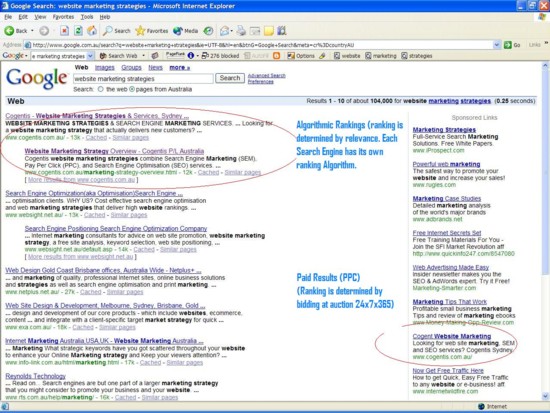
SEARCH ENGINE MARKETING & SEARCH ENGINE OPTIMISATION EXPLAINED
Home About Cogentis Positioning Services Strategy Overview News Contact Cogentis

Search Engine Marketing and Search Engine Optimisation - whats the difference?
Recently it was asked 'what's the difference between search engine marketing (SEM) and search engine optimisation (SEO)'? Generally - there is confusion about these two terms - experts don't even agree! Here's our take on the definitions of these two terms - and the differences between the two processes.
Search Engine Marketing defined:
Search engine marketing (SEM) refers to the short text advertisements which generally appear at the top or down the right hand side of search engine results. These are often labelled as "sponsored Links" or "sponsored results". These advertisements are generally purchased from GoogleTM (the Google AdwordsTM product), or Yahoo! Search Marketing (YSM - formerly Overture)TM (YSMTM supplies the paid search advertisements to Yahoo!TM Search, and ninemsn Search, here in Australia).
Advertisers bid in a never ending 24x7x365 auction to determine the highest placed advertisement. Google's system also factors Click Through Rate (CTR) in its ranking of advertisements. Search Engine Marketing process is often generically referred to as "pay per click" (PPC) advertising because you only pay when someone clicks on the advertising link, not when your advertisement is displayed.
Search engine marketing (or, more correctly, search engine advertising) is effectively paid advertising in search engines, where you 'Pay Per Click' (PPC). It is text advertising delivered in response to 'trigger' words typed into the search box. The surfer types in a search phrase, the PPC advertisements which have bid on that phrase are displayed, and if the surfer clicks on a text advertisement they are taken to the advertiser's website. At that point, the advertiser's account is charged for the 'click through' by the search engine's advertising partner.
Search Engine Optimisation defined:
Search Engine Optimisation (SEO) is defined as the process of building pages in a manner which enables the pages to rank highly in 'algorithmically' determined search results, which are generally displayed on the left hand side of the page. The 'algorithmic' results are independently determined by the search engine's own mathematical algorithm, and are based on relevance to the search phrase. Search engines use complex mathematical algorithms to determine the relevance of indexed pages for a particular search phrase. The algorithms are generally understood to factor over 100 'on the page' (i.e. the words used on the page itself, their location, repetition etc.) and 'off the page' (i.e. links pointing to the page, site popularity etc.) aspects in the calculation of their results.
Search engines index HTML code. Before a website can rank in a search engine, it has to be designed with accessibility in mind. Search engines are effectively text browsers with no plugins (no Javascript, no Macromedia Flash). If a site isn't accessible - i.e. the site/ page can't be 'seen' or 'read' by a search engine, then the site/ page can't be indexed by the search engine. Links that can't be seen - can't be followed by the search engine. Many 'cool' web design tools produce content which can not be seen or read - and therefore can not be indexed by search engines. Search engines can't index 'pictures of words'.
Pros and cons of SEO and SEM:
Search Engine marketing (SEM) is an 'instant gratification' advertising media. You can basically set up a Google Adwords campaign in half an hour - and often have your advertisements running within the hour. Try that with newspapers, TV or radio! You don't have to make any changes to your website structure or architecture. You don't have to know how your website is built. And best of all - you only pay when your advertisement is clicked on - not when it is shown.
So whats the downside of SEM? Well - you pay whenever your advertisement is clicked on. You 'Pay Per Click' (PPC) - and will keep paying per click for all your traffic. You'll even pay for clicks by your competitors. The issue of 'click fraud' is a growing problem - and although every major PPC system claims to have ways of detecting click fraud - its out there.
Search Engine Optimisation is a longer term approach, and encompases many 'best practice' web design standards. There are often no payments required to the search engines, as the major search engine spiders (robots) visit your site for free (i.e. GoogleTM, and Yahoo!TM), add it to their index, and rank it for relevancy against mathematical parameters. Good content, targeting well searched phrases, built to the 4 pillars of accessible web design (and built to conform to the published rules) - often win in the search engine rankings.
A holistic website marketing strategy will address both forms of search engine traffic. At Cogentis, we understand both search engine optimisation and search engine marketing - and the implications of accessibility for your human users and search engine spiders. One of the first steps in formulating a website marketing strategy is assessing the implications of your site design, and the technology deployed, to ascertain the options available to you.
Our process is logical and cogent. Through our web-site analysis services, we can ensure that your site is accessible, and hasn't penalised itself in search engines, by its design and technology. Cogentis specialises in internet positioning services and strategies.
Cogentis Home |
About Cogentis |
Positioning Services |
Strategy Overview |
Contact Cogentis |
Web Accessibility
Privacy Policy |
Terms Of Use
Cogentis Pty Ltd © 2004 - 2006
